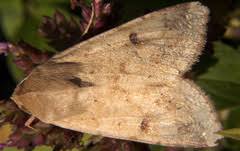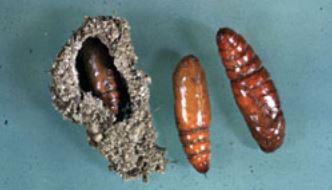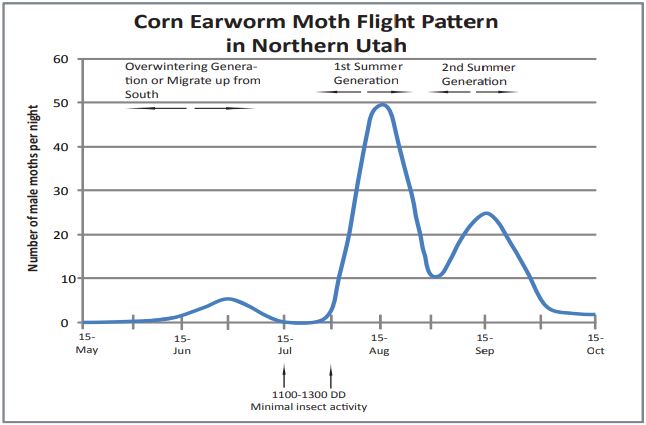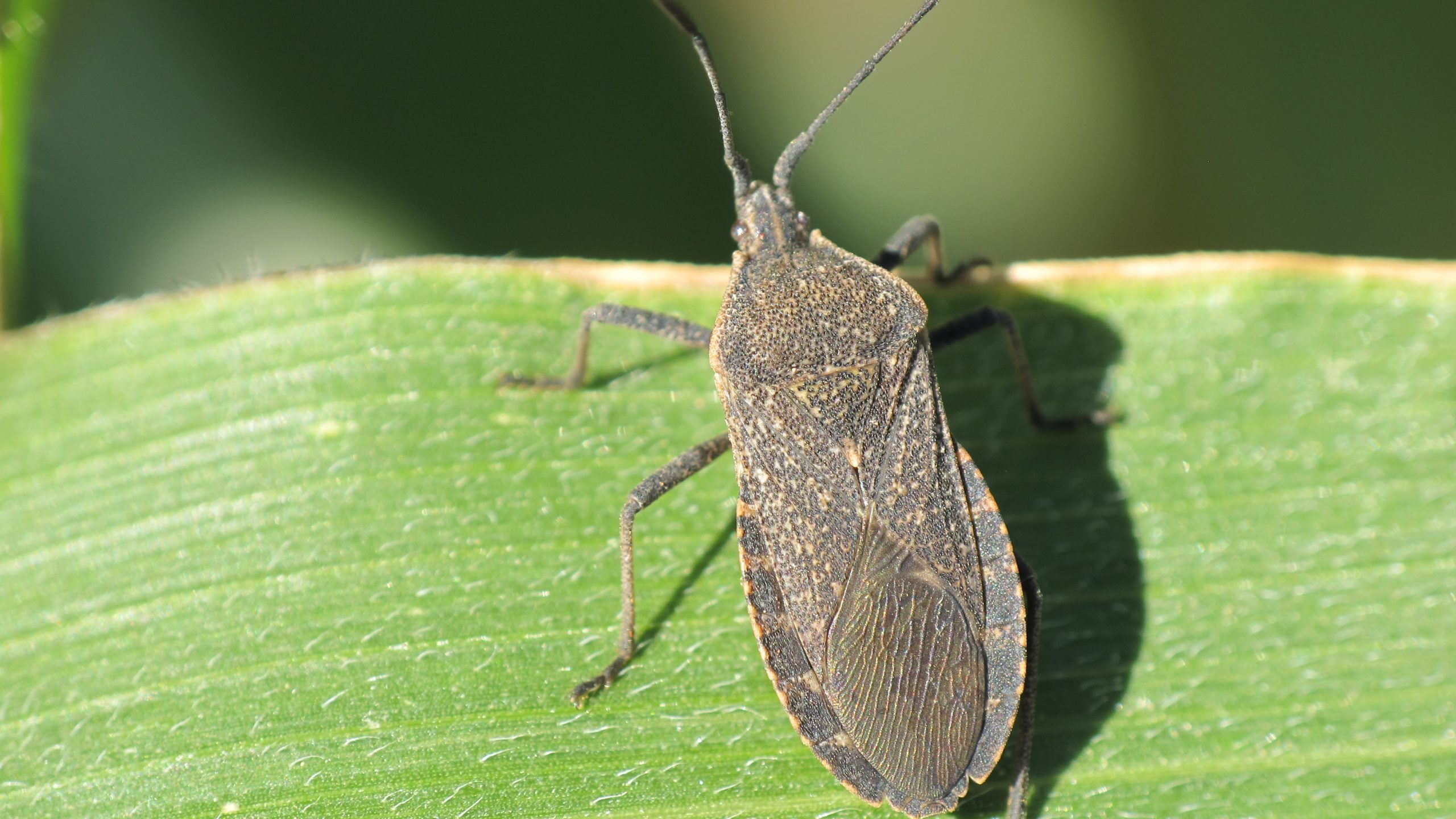Corn Earworm
[Helicoverpa zea (Boddie)]
December 2011
Diane Alston, Extension Entomologist (No longer at USU) • Shawn Olsen, Agriculture Extension Agent (Davis County) • James Barnhill, Agriculture Extension Agent (Weber/Morgan Counties)

Fig. 1. Larvae feed on corn kernels within the ear. Larvae vary in color from green to brown to black. Image courtesy of University of Minnesota Extension.

Fig. 2. Moths have tan wings with a distinct spot and dark margin on each forewing. Image courtesy of Bruce Martin, cirrusimage.com.

Fig. 3. Corn earworm moths lay their eggs on fresh corn silk. Note the tiny white eggs stuck on the silks. Image courtesy of Cornell University.

Fig. 4. Pupae are formed within an earthen cell 2 to 5 inches deep in the soil. Image courtesy of Cornell University.



Fig. 5. Trichogramma are tiny wasps that parasitize insect eggs. Image courtesy of North Carolina Cooperative Extension.
Quick Facts
- Corn earworm (CEW) is the most destructive insect pest of sweet corn in Utah
- CEW will also attack field corn, and pepper and tomato fruits
- The adult is a tan-brown moth that is most active at dusk; moths can be carried on wind currents, and may travel up to 300 miles in one night
- Monitoring moth populations with pheromone traps informs growers when densities are high enough to warrant spraying
- CEW overwinters as a pupa in the soil in central, and southern Utah; and immigrates into northern Utah each spring
Life History
In Utah, there are typically three generations of corn earworm (CEW) each year. The first generation of adults either come from overwintering pupae (southern and central Utah), or migrate into northern Utah. The adult moth is tannish brown with a 1 1/2 inch wingspan. The front wings are marked with a distinct dark spot in the center and darker bands near the outer margins. The hind wings are lighter tan, with a dark band along the outer margins. The male moths have green eyes. Moth flight occurs primarily on warm, overcast evenings. Moth populations can be monitored using pheromone or black light traps.
CEW moths prefer to lay eggs singly on fresh, green corn silks. Each female moth can lay up to 1,000 eggs. Moths will lay eggs on weeds and selected vegetables when corn silk is unavailable. This provides a population that is ready to attack corn as soon as silks are present. Eggs are very small, one-half the size of a pinhead. They are creamy white and dome shaped with ridges; darkening in color as they near hatching. The eggs can be seen with the aid of magnification. Egg monitoring is difficult due to their small size and location. Eggs hatch in 2 to 10 days, depending upon the temperature.
On corn, the newly hatched larva crawls down the corn silk and into the ear tip. It prefers to feed on the developing kernels in the ear, but will also chew on silks and leaves. On tomato and pepper, it tunnels into the fruits and chews on leaves. CEW strongly prefers corn to other hosts, and damage to corn is much more prevalent. The larva is a brown-headed caterpillar with a green, brown, or black body. Alternating dark and light stripes run lengthwise on the body. Larva length ranges from 1/10 inch (1.5 mm) up to 1 1/2 inches when fully grown. Larvae are cannibalistic and so usually only one is found per ear. The larva feeds within the ear for 10 to 14 days, then exits and drops to the ground. They burrow 2 to 5 inches deep into the soil and pupate.
The pupa is a resting stage. The pupa is cylindrical, brown, about 1 inch long, and remains in the soil. The adult moth emerges within 10 to 25 days during the summer. Pupae formed in late summer may overwinter in warmer climates, otherwise they are killed by cold winter temperatures.
Crop Injury
In corn, CEW causes several types of injury:
- Direct damage to the ear tip by feeding on kernels
- Damage to silk that can decrease pollination leading to poor earfill
- Produces frass from feeding; this reduces quality, storage life and appearance
- Increases mold growth within the ear
- Increases sap beetle and earwig infestation by providing an opening in the husk at the ear tip
In tomato and pepper, CEW larvae:
- Tunnel into fruits reducing their quality and marketability
- Chew holes in leaves, stems, and flowers reducing fruit yield and quality
Moth Flight Pattern
There are typically three flights per year in northern Utah. The first flight is small and begins in mid-June to early July. The second and third flights are much larger and occur during August and September, respectively. In northern Utah, most first generation moths immigrate from overwintering sites in central and southern Utah. However, observations that fields with high levels of larvae in the fall tend to have higher levels of infestation the next spring support the hypothesis that some pupae overwinter. In southern Utah the first flight will begin 3 to 4 weeks earlier than in the north, and there may be a fourth generation each year.
Monitoring
Using Traps: The CEW is best monitored using a pheromone lure in a net trap. The pheromone is the sex attractant of the female moth that has been synthetically reproduced and incorporated into a lure. Traps are cone shaped and usually made of vinyl mesh netting. Some guidelines for using traps are:
- Scentry and Hercon pheromone lures have been the most reliable in Utah studies
- Place the trap by early June along the edge of a corn field; attach the trap to a stake or post so the bottom of the trap is about the same height as the corn silk
- Check twice weekly until first catch, then check daily or every other day for best results
- Moths are collected in the top of the trap; remove trap top and kill moths by crushing, freezing, or transferring them to alcohol or a jar containing nail polish remover
- Calculate the average number of moths caught per night over the trapping interval; if the trap is checked daily, calculate the nightly average over a 3 to 4 day period to reduce night-to-night trap catch variance
- A threshold level for control is 0.2 CEW moths per night
- Move trap to different areas of the field to keep it near fresh corn silk
- Replace the lure every 2 to 3 weeks (follow manufacture guidelines)
- Moths other than CEW may enter the trap; only count CEW moths
Using Degree Days: The rate of insect development is primarily controlled by temperature. Degree days (DD) can be used to predict when moth flight will occur (see “Using Degree Days to Time Treatments for Insect Pests” for more information). The lower and upper development thresholds for CEW are 55° F and 95° F, respectively. Daily DD’s can be summed over time for each year beginning on approximately March 1. The interval from 1100 to 1300 DD corresponds to an 8 to 10 day period between the first and second generations when little moth flight and egg-laying activity occurs. This interval typically occurs in late July to early August. Little, if any, spraying is needed during this interval.
Monitoring is important because hornworm larvae can easily blend in with the foliage, so they may not be detectable until after damage has begun to occur. Begin monitoring in early July before hornworm populations reach their peak in mid-summer. Larvae tend to hide during the day, so scout in early morning or evening. Tomato plants are typically a good host plant to initially check in fields and gardens. Shake a portion of the plant over paper or cardboard to dislodge any larvae. Inspect a selection of plants for feeding damage on the newer foliage. Look on the foliage and ground for dark green-black frass pellets (excrement), which will be plentiful even with a few larvae present.
Management
Chemical
In corn, good control is dependent on applying insecticides before larvae enter the ears. Start spraying within 2 days of the beginning of silking, or as indicated by trap counts. About half of the eggs are laid within 2 days of silk emergence, and the remainder of the eggs are laid by 9 days later. Reapply insecticides to keep an active residue on new silk. Silk grows about 1/2 inch per day. Once silks turn brown they are no longer attractive as egg-laying sites.
The following reapplication intervals are based on guidelines from Maine and seem to work in Utah. Reapply insecticides using the suggested intervals while silks are still actively growing. Stop sprays when silks turn brown.
| Number of Moths Trapped per Night | Insecticide Reapplication Interval (Days) |
|---|---|
| Less than 0.2 | None |
| 0.2 to 0.6 | 5 |
| 0.7 to 6.5 | 3 |
| More than 6.5 | 2 |
- Bacillus thuringiensis (Dipel, Thuricide, others)H,O - not effective on moths, must be ingested by larvae; effective in tomato and pepper if reapplied every 2 to 3 days; not effective in corn
- bifenthrin (Brigade)R
- carbaryl (Sevin)H - toxic to bees; Sevin XLR formulation is less toxic than others
- cyfluthrin (Baythroid)R
- esfenvalerate (Asana)R
- horticultural mineral oil (many brands)H,O - suffocate eggs on silks, must reapply every 2 to 3 days for suppression only
- lambda-cyhalothrin (Warrior)R
- malathion (Malathion)H
- methomyl (Lannate)R
- permethrin (Ambush, Pounce)R
- spinosad (Spintor, Success, EntrustO)H- effective upon ingestion by larvae, but no contact activity; effective for tomato and pepper, but not corn
- thiodicarb (Larvin)R
- zeta-cypermethrin (Mustang)R
OOrganic (OMRI-approved) products available.
HHomeowner products available.
RRestricted use insecticide; restricted to those with a pesticide applicators
license only.
All brands are registered trademarks. Examples of brands may not be all-inclusive, but are meant to provide examples of products registered in
Utah. The availability of pesticides may change. Always read the label for
registered uses, application and safety information, and protection and
pre-harvest intervals.
Cultural
Sweet corn planted early so that it will silk before major moth activity occurs, may escape injury. Corn silking between first and second generation flights (July 20 to August 5 on average in northern Utah) may also not be damaged.
Fall tillage of corn fields decreases survival of pupae. In locations where corn earworm pupae overwinter, fall tillage is an effective practice.
Biological
Trichogramma wasps parasitize corn earworm eggs. The wasps can be purchased from vendors and released in the corn field. The timing of releases and maintenance of adequate wasp populations are critical to success. Wasps have been used with limited success in Utah.
USDA scientists have recently discovered a virus that prevents corn earworm from mating. It is called the gonad virus and may be a potential biological control in the future.
Corn earworms in all life stages have some natural parasites and predators, but their numbers are typically inadequate to provide control.
Related Research

















